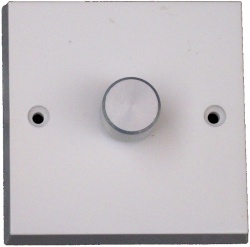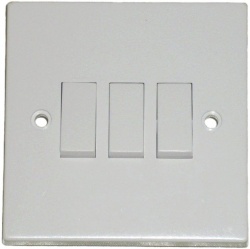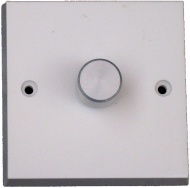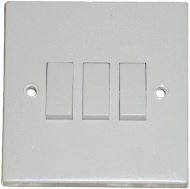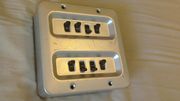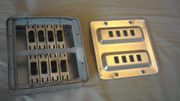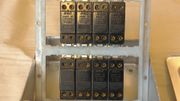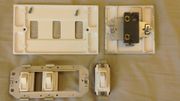Difference between revisions of "Dimmers & Switchbanks"
| Line 58: | Line 58: | ||
==Switchbank== | ==Switchbank== | ||
| − | [[image:Switchbank_new_1083-6.jpg|right|190px]][[image:GEC-grid-1.jpg|right|180px]][[image:GEC-grid-2.jpg|right|180px]][[image:GEC-grid-3.jpg|right|180px]]MK-Grid-1. | + | [[image:Switchbank_new_1083-6.jpg|right|190px]][[image:GEC-grid-1.jpg|right|180px]][[image:GEC-grid-2.jpg|right|180px]][[image:GEC-grid-3.jpg|right|180px]][[image:MK-Grid-1.jpg.jpg|right|180px]][[image:MK-Grid-2.jpg|right|180px]] |
| + | |||
A '''Switchbank''' is a bank of 2 or more switches, where each switch controls some of the lights in a room. More than one [[lighting]] level is thus achieved depending on the number and combination of lights turned on. | A '''Switchbank''' is a bank of 2 or more switches, where each switch controls some of the lights in a room. More than one [[lighting]] level is thus achieved depending on the number and combination of lights turned on. | ||
| Line 79: | Line 80: | ||
====More Switches==== | ====More Switches==== | ||
| − | Large and specialist lighting installs may require more switches. Standard double faceplates come with upto 6 switches. To get even more switches requires either a gridswitch, additional faceplates, or a custom switch assembly made from a blanking plate. The gridswitch is the usual choice, and can incorporate dimmers and indicators etc as well as switches. | + | Large and specialist lighting installs may require more switches. Standard double faceplates come with upto 6 switches. To get even more switches requires either a '''gridswitch''', additional faceplates, or a custom switch assembly made from a blanking plate. The '''gridswitch''' is the usual choice, and can incorporate dimmers and indicators etc as well as switches. |
Each additional switch doubles the number of available lighting patterns, hence 3 and 4 gang switchbanks are normally plenty. | Each additional switch doubles the number of available lighting patterns, hence 3 and 4 gang switchbanks are normally plenty. | ||
Revision as of 09:53, 12 July 2019
Dimmers & Switchbanks are both ways to control lighting levels, improving both utility and comfort.
This article sets out the advantages of controlled lighting levels, and looks at the relative merits of different ways of achieving them. Some installation notes are also included.
Advantages of Lighting Level Control
Controllable lighting brightness permits
- Relaxed lighting in the evening
- Bright lighting when its needed for a task
- Improved safety by allowing lighting level to be selected which is appropriate for the task in hand.
- Better comfort and better visibility.
- May reduce energy use
Methods of Lighting Level Control
Dimmer & dimmable lamp
A Dimmer is an electronic control that reduces the power flowing through the lamps it controls, which in turn causes a continuously variable change in brightness to be achieved.
Depending on the lamp technology, the reduced brightness may also reduce the energy consumption. Note that a filament lamp will still use a significant proportion of its "full brightness" energy, even when dimmed.
Dimmers don't require any overlap in lighting areas to achieve their effect.
Compatibility
Standard dimmers have restrictions on the types of lights they will run.
- Fully compatible with mains filament bulbs
- Fully compatible with mains halogens.
- Compatible with most electronic 12V halogen lighting transformers, but not all.
- Not compatible with toroidal halogen lighting transformers.
- Compatible only with CFLs specifically marked as dimmable
- Compatible only with LEDs specifically marked as dimmable
- Not compatible with linear fluorescent unless fitted with special dimmable electronic ballast and compatible dimmer switch
- Not compatible with discharge lighting (HID, sodium, mercury)
Note that the dimming range for some dimmable LED and CFL lamps can be far narrower than for an incandescent lamp - typically the dimmest setting is quite a bit brighter than that of an incandescent lamp (this however does depend on the dimmer - ones specifically designed for LED use for example tend to achieve far better results.
Also note that unlike an incandescent lamp the colour temperature of LED and CLF lamps does not get significantly lower as they dim - so they can seem somewhat "cold" looking when dimmed.
Reliability
Dimmers themselves aren't as reliable as switches, and failures do occur occasionally. 250w dimmers are rather less robust on the whole than 500w dimmers.
Filament bulbs occasionally consume a heavy current surge on failure, due to arc-over. Such a current surge has a high chance of destroying a dimmer. These surges are more likely to occur with
- small form factor mains filament bulbs (especially mains halogen)
- short cable runs.
Some dimmers include "soft start" facilities. These may enhance the life span of halogen lamps in particular.
12v bulbs and non-filament type lamps don't suffer from this.
Dimmers should not be loaded past their max rating, this elevates failure rate greatly. Note also that many dimmers also have a minimum load required for correct operation - this can be a problem with some LED loads due to their low current draw.
Wiring Arrangements
A dimmer usually replaces an existing switch, with no added complication. (although note that remote control dimmer switches may not work with low energy lamps unless a bleed resistor is also fitted to allow a small current to flow through the lamp when "off")
The exception to this is when two way operation is required. If you wish to control brightness from both switch positions then a special master / slave dimmer switch will be required. Conventional dimmers will allow two way switching, but not two way brightness control.
Switchbank
A Switchbank is a bank of 2 or more switches, where each switch controls some of the lights in a room. More than one lighting level is thus achieved depending on the number and combination of lights turned on.
To operate well, switchbanks require lights to have overlapping lighting areas; so a long room with only two lights, one at each end, may not be an ideal candidate for a switchbank. Uneven lighting can be an issue when fitting switchbanks to an installation with a minimum number of lights, as was common practice in the 1970s and before.
When using a switchbank with multiple downlighters, there are various ways to distribute the lights among the switches. Groups of lights on each switch and alternate lights on each switch are both popular options. What works best depends on the room and lighting layout.
2 or 3 switches are often enough for most rooms. More switches make for more possible lighting patterns or levels if desired.
Compatibility
Switchbanks are compatible with all types of lighting.
Reliability
Switchbanks are as reliable as any other light switch arrangement. If more lights are fitted at the same time, that translates to more routine bulb replacements.
Installation Tips
Single sized standard light switches come with up to 4 switches, plenty for most rooms.
More Switches
Large and specialist lighting installs may require more switches. Standard double faceplates come with upto 6 switches. To get even more switches requires either a gridswitch, additional faceplates, or a custom switch assembly made from a blanking plate. The gridswitch is the usual choice, and can incorporate dimmers and indicators etc as well as switches.
Each additional switch doubles the number of available lighting patterns, hence 3 and 4 gang switchbanks are normally plenty.
- A 2 gang switch gives 3 lighting levels, if the lights are of different wattage
- A 3 gang switch gives 7 lighting patterns/levels
- A 4 gang switch gives 15 lighting combinations & levels!
Shown at right, an 8-gang GEC metalclad gridswitch with 8 intermediate switches. This would have 32 strapping wires connected to the switches, plus CPCs and any neutrals passing through the box.
Wiring Arrangements
Loop-in
Loop-in is the most common lighting circuit arrangement. Power is daisy-chained from each lighting fitting to the next, and a separate switch wire connects a switch to each fitting. This is simple and easy to implement for general lighting wiring, but is not compatible as it stands with switchbanks. To retrofit switchbanks into such a system would require additional wiring, complicating the wiring layout.
Switch loop through
The other method in use for domestic lighting is to run the power feed to the switch first rather than the lighting (so power feed to the next room is taken from the switch position and not from a light fitting). From the switch, a cable with neutral, earth & switched live is run to the lighting. A minority of house lighting is wired this way.
When more than one cable is run from the light switch to more than one light fitting, a switchbank can be retrofitted without adding any further wiring. However in most retrofit cases such wiring is not already present. Hence switchbanks are more often fitted at new installation and rewire times rather than retrofitted.
Combined dimmer & switchbank
Another option is to combine both techniques. There are a few possible ways to do this:
- Dimmer followed by switchbank
- Multiple dimmers
- A switch for some lights, and a dimmer for the other lights
This gives some the advantages of a switchbank while retaining the continuously variable nature of the dimmer.
Switch dimmable low energy lamps
Lamps are available that will select more than one brightness level, controlled by operating an ordinary lightswitch a number of times in sequence. These allow dimming with no wiring changes.
Compatibility
As only the bulb is changed to get this feature, the fitting remains compatible with all lighting types. These are not usually compatible with conventional dimmer switches.
Home automation dimmers
Dimmer systems are available for integration with home automation systems. These are typically controlled by either proprietary RF signalling, or more commonly, by WiFi. These allow brightness (ans in some cases colour) to be controlled from an "App" on a smart phone or tablet. With home automation systems wither the lamp socket itself can be "smart" or you can opt for "smart" bulbs.
Boost & dim
An 18v transformer can be used to provide 3 settings of boost, normal and dim for filament lamps. The result is significantly better energy efficiency that just a dimmer. The transformer is wired to give 222v, 240v or 258v.
Its also possible to implement 2 brightness settings by using a bridge rectifier and capacitor, to give normal and boosted rms voltage.
Full discussion: Bulb Boosting & Switchable Boost
Compatibility
Compatibility depends on the method chosen. See Compatibility
Dimmable fluorescent
A dimmable fluorescent ballast enables dimming fluorescent tubes over a wide range. A dimmer control compatible with the ballast must be used.
How to make a fluorescent fitting unseen How to ensure good light quality
Fitting
Dimmer
Dimmers just replace a lightswitch in an existing installation, with no need for any extra wiring to be installed. Retrofitting is easy, and the cost minimal.
Switchbank
If 2 or more light fittings have their own cables running to the switch, then a switchbank can be fitted very easily. Its just a case of replacing the old switch.
But more often there are no separate cables, and extra cable needs to be run to retrofit a switchbank. This heavily limits their retrofit use in practice.
Retrofit cost is trivial in the first case, but requires additional new cable(s) in the 2nd case.
The extra cost of fitting a switchbank when building new is trivial.
A switchbank can also be used to mix or choose between filament and other lighting. One example of this would be concealed fluorescent uplighting with halogen spots for task and feature lighting.
Bulb Life
Switchbanks have no effect on lamp life.
Dimmers usually soft start lamps. This extends mains halogen lamp life to some extent, but may make less difference with all other types of lamp.
Switch dimmed cfls and dimmed linear fluorescent tubes last far longer than filament lamps. Dimming them has little effect on lamp life. Linear fluorescent tubes on electronic ballasts see around 20,000 hour life average.
Boost dimming reduces filament lamp life when on max setting.
Energy Efficiency & Running Cost
While it is often assumed that fitting a dimmer will reduce energy use, the reality may be more complex. If you elect to use a more powerful filament lamp than you otherwise would have, running costs may actually increase.
If frequently using less than maximum brightness illumination, the energy saving potential of a switchbank is much greater.
For users who normally always run their lamps at maximum brightness illumination, neither option will save significant energy or cost.
Summary
- Switchbanks are a good idea for new installs.
- Dimmers are the neat option for multi-bulb chandeliers.
- Dimmers are significantly easier and thus cheaper to retrofit than switchbanks.
- Dimmers give the greatest amount of lighting level control
